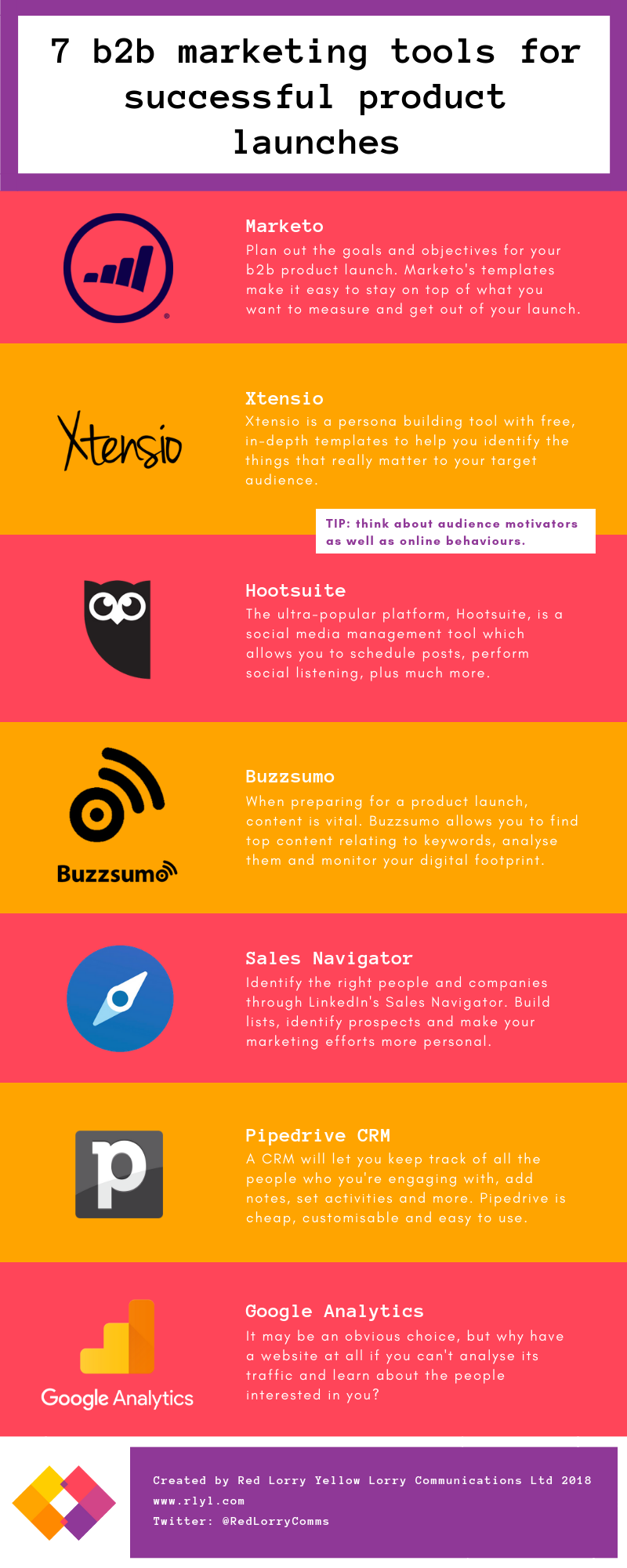Here you’ll find insider tips from PRs and marketers about b2b content marketing and strategy. It will include how to create content, manage and promote content and generally make the most of your content assets. Over the coming months we’ll be adding more and more information so keep coming back or sign up to our newsletter to keep updated.
Quick links:
- B2b marketing strategies to freshen your content
- Talking TechComms – writing content for communications [PODCAST]
- How to craft b2b thought leadership that can compete in a crowded marketplace
- B2B content marketing | Tell your story and reap the rewards
- [INFOGRAPHIC] 7 b2b marketing tools for product launches
- LinkedIn Campaign Manager’s New User Interface: to bid or not to bid?
B2b marketing strategies to freshen your content
By Dan Simpson
Times have changed incredibly quickly when it comes to the types of content we now consume on a daily basis. Whether you work for a b2b or b2c company, it is always important to remember that behind every screen is an individual. In the b2b world, the people behind the screen may be in work mode and engaging with content of a different subject matter than they might do at home, but as individuals, both consumer and work content will stand out to them in the same way and that’s important when considering b2b marketing strategies.
Although still widely used, the “content is king” mantra is an outdated mindset for companies who want to stand out against their competitors, having been replaced by “context” as the defining factor. Today, however, context alone isn’t enough. A trio of context, convenience and creativity must now go into content, but even if you have the best piece of content in the world, content promotion is the real key to acquiring an engaged and loyal audience. Breaking down “the three C’s” is important before you start creating and promoting, so let’s take a closer look at them:
Talking TechComms – writing content for communications
By Sam Pudwell
It’s no secret that content creation is playing an increasingly central role in marketing and communications strategies. More and more brands are using content as a way of reaching beyond traditional media relations and engaging different audiences to meet different business needs. But what do brands need to keep in mind when developing content? And how can they get the most out of their investment?
In this episode of the Red Lorry Yellow Lorry ‘Talking TechComms’ podcast, London lorry Martin Izzard sat down with content manager Sam Pudwell, to discuss why content is now so essential and offer some advice to help brands make their contact as impactful as possible.
Check out the full discussion below:
How to craft b2b thought leadership that can compete in a crowded marketplace
Today, 473,400 tweets are tweeted, 49,380 Instagram posts are shared, and 4,333,560 million YouTube videos are watched every minute. We’ve come a long way in only the past few decades, back when most people only had access to a few TV channels or newspapers and had to take a trip to the local library to get their information. We are currently experiencing what could only be described as ‘content fatigue’, and with research indicating that the amount of content available online is doubling every 9 to 24 months – there’s currently no end in sight.

There is now more content online then anybody could possibly consume in one lifetime. But though the supply of content stands at an all-time high, the time in which professionals must engage with it has stayed relatively static and remains finite. Not only is your organisation’s content competing with almost every book, film, and TV show that has ever been published (which can all be found online), the 3.8 billion people that now have internet access are taking the chance to share their ideas, voicing their opinions on social media or personal blogs in their millions. Today everyone has become a content creator.
What’s more, the level of distrust in what we are interacting with online has reached an all-time high. Americans believe that 80% of the news they consume on social media is biased, and in Europe, Brits aren’t that much more trusting, with only 42% trusting online news. It’s now imperative that companies take the right approach to crafting content that can stand out in an increasingly busy landscape, and that can satisfy the demands of an ever-more discerning reader base.
But that doesn’t mean that you should consign your company’s b2b message to drowning in an ocean of content. It’s still very much possible to capture a big audience in world where everyone is curating their own reading list. Here are some guidelines to help you along the way.
- Be different
When producing content that reflects on a large corporation, it’s easy to succumb to the temptation to simply play it safe. But saying the same things about the same topics as everyone else, is no longer the way to success when it comes to reader engagement – if it ever was.
The onus is now on organisations to take a step back and consider if what they’re saying about blockchain, AI, or other topics is really that unique. Though b2b audiences are constantly bombarded by content from companies looking to establish themselves as thought leaders, they are also actively seeking out new insights to give themselves a competitive advantage. This means being ready and willing to rock the metaphorical boat if the situation calls for it. This doesn’t mean appointing Kanye West as your Head of b2b Content, but you might have to be prepared to break out of the established mode of conversation on the topic that you’re looking to comment on.

In influential marketing book ‘The Purple Cow’, the author Seth Goodwin argued that for a company to garner attention they had to produce a product which will naturally stand out in comparison to the competition. If the product is exceptional enough, it was argued that the attention would come about organically. The same goes for b2b thought leadership and the approach you take to content marketing. If you don’t make the effort say something original or think of a more original way to get that message across, it’s easy to get lost in the noise.
- Play to your competencies
With competition for the eyeballs of business decision makers at record levels, it is more important than ever that companies provide a level of insight which their competition can’t. This necessitates that companies pay closer attention than ever to what their spheres of competence are. But that doesn’t mean you can’t try and delve into new topics of conversation.
It does mean being willing to take a step back and take an objective look at what you can bring to the table. What are your specialities? And where can your organisation bring value and insight where other people can’t? Even smaller organisations are likely to have people with unique and hard to replicate skill sets, either from their current or past experiences, that can be tapped into to create a lot of value to a specific audience. You can use this knowledge to create content that stands out.
- Be objective
In the era of ‘content fatigue’, there is no longer room for content that isn’t well researched, well written, and well thought out. With an excess of blogs and articles all simultaneously vying for readers’ attentions, rushed and self-serving pieces are no longer acceptable. It is now necessary for b2b content marketers to invest A-grade effort if they want to receive A-grade results.
This means that objectivity is now a must. Though your company may believe that your latest product launch is the most important thing ever to happen in the world of technology (and perhaps it is), organisations need to be able and willing to take a 3rd person viewpoint on the quality of their output.

But you don’t have to go it alone, there is outside help available when it comes to maximising the pull which your content has to the right audiences. Though it isn’t necessary to outsource the process completely, it may be wise on incorporate a level of third-party involvement. For example, ex journalists, PR agencies or specialist content agencies may have insight about what is likely to play well in the media and rack up hits online, that they’ve been able to gather from years of experience working in content. It would be wise to make use of these insights if you have the budget. Similarly, using influencers from outside of the four walls of your company in the content itself, not only provides objectivity, it gives credibility to your views and encourages new shares. These influencers can be journalists, analysts, industry experts or even clients or prospects. If your influencer adds your content to their social channels, it also has the potential to increase views beyond your company’s bubble.
- Know your audience
In today’s knowledge economy, job roles – particularly in technology – are becoming more and more specialised. It’s not new. ‘Hyperspecialisation’, was coined by Adam Smith in his The Wealth of Nations, 1776 but is still relevant today. Factors of production are broken down into smaller and smaller parts, and work that was previously done by a single person is now broken down into smaller pieces delegated to multiple people. For example, something as simple as ‘software development’ can now be broken down into project management, coding, DevOps and testing.
B2B content marketers need to be aware which element(s) of the IT continuum they are speaking to. Rather than trying to please everyone (and ending up pleasing no-one), it’s better to know your audience and create something that is specially tailored to them, based on an explicit understanding of their wants, needs and the subjects that interest them. You’re a lot more likely to reach your target audience if you know who they are in the first place. One good way to do this is to build personas around your ideal audience. Typically, a persona includes:
- basic demographic points such as age, education level and family details
- company sector
- job title
- goals
- motivations
- challenges/ pain points they face
You might find a persona building tool like Xtensio with its free templates, useful in creating detailed personas. Check out our previous article about planning the perfect b2b product launch, where we talk more about Xtensio.
- Keep it simple
The ever-expanding availability of content and modern distractions has not been without its casualties. Attention spans are now shorter than ever. In 2013 a new term was added to the Oxford English dictionary: ‘TL;DR’, which stands for ‘too long didn’t read’, and this is symptomatic of the world’s current ADHD attitude to content. A survey of Canadian media consumption from Microsoft concluded that the average attention span has fallen to eight seconds, down from twelve in the year 2000.

People continue to want new insights, but they want them delivered in a format that respects the value of their time. If you are after engagement especially around video and social content, it’s still vital to try and avoid unnecessary generalities, your company’s message should be as short as possible, with no unnecessary fluff. Now that’s not to say that written long-form content doesn’t have its place. Longer form thought-leadership content (1000 words +) can help with SEO and being picked up in search engine results. The key isn’t to keyword stuff, it’s to write good quality, error-free and useful content.
It’s hard to question the ongoing value of thought leadership as an investment. Research from LinkedIn shows that 92% of b2b marketers are using content marketing in some shape or form. And it’s easy to see why. In 2016 alone, IT professionals started to consume 38% more b2b content, and 54% of IT readers consumed more than one piece. The global b2b audience is larger and more global than ever before, and investments in thought leadership are still worthwhile in helping you talk to them
Being able to craft content that takes advantage of specialised knowledge bases to communicate to increasingly niche b2b audiences in a non-generic way, while still incorporating the level of quality and brevity that they have come to expect, is invaluable. That’s why b2b content marketing still represents a necessary investment, regardless of the level of competition.
B2B content marketing | Tell your story and reap the rewards
Content marketing is having a moment. As we look back at last year, you could argue that B2B content marketing came of age in 2017. It didn’t dominate the lexicon quite like the oft-used (and now tired) ‘content is king’ platitude but it’s the logical next step of that truism. And it’s here to stay.
In many ways, B2B content marketing is an outgrowth of the rise, and critical importance, of digital marketing. It’s become absolutely fundamental to success in today’s B2B landscape. Whether you’re a large multinational brand or niche technology company, content marketing should be a core component of your digital strategy.
[INFOGRAPHIC] 7 b2b marketing tools for product launches
By Dan Simpson

A targeted go-to-market strategy and B2B product launch plan are critical to success – both short- and long-term. After you’ve determined demand, done your due diligence around competitive offerings, and completed the time-intensive R&D heavy lifting, you can’t simply coast through the promotion phase. Many would argue that this is one of the most crucial b2b product launch plan steps and where many companies fail.
LinkedIn Campaign Manager’s New User Interface: to bid or not to bid?
By Dan Simpson
November 14th might seem like any other day of the week but, after a quick Google Search, to my surprise, I found out that it’s actually home to a variety of different ‘celebrations’. These include Operating Room Nurse Day, World Diabetes Day, and arguably the most important, Spicy Guacamole Day (who isn’t going to go home from work and make the most of that?). One thing that doesn’t come around every year though, is a (long overdue) update to LinkedIn Campaign Manager (it’s advertising platform) and the promise of a new Objective-Based Advertising UI.
I’ll be the first to say that the old LinkedIn Campaign Manager UI was a pain from start to finish. Its unintuitive campaign management and unexplained error messages caused headache after headache. The simplest of tasks became arduous and a nightmare for b2b marketers, especially when it came to managing multiple campaigns. But, from November 14th there’s a new kid in town and it’s called Objective-Based Advertising. Will it bring the changes that b2b marketers deserve?




